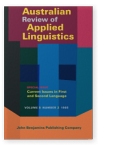Relationships between second language acquisition research and second language teaching
References (12)
References
Breen, M.P., C. Candlin, and A. Waters (1983) Communicative materials design: some basic principles. In Richards, D. (ed.) Concepts and functions in current syllabuses. RELC Occasional Papers, 301: 111–123. Singapore, RELC.
Corder, S.P. (1967) The significance of learners’ errors. IRAL, V, 41: 161–170.
Krashen, S.D. (1981) Second language acquisition and second language learning. Oxford, Pergamon.
Krashen, S.D., and T.D. Terrell (1983) The natural approach. Oxford, Pergamon.
Littlewood, W.T. (1984) Foreign and second language learning. Cambridge, Cambridge University Press.
Pienemann, M. (1985a) Learnability and syllabus construction. In Hyltenstam, K. and M. Pienemann (eds.) Modelling and assessing second language acquisition. Clevedon: Avon, Multilingual Matters Ltd.
Pienemann, M. (1985b) Psycholinguistic principles of second language teaching. To appear in Applied Linguistics.
Prabhu, N.S. (1984) Procedural syllabuses. In Read, J. (ed.) Trends in language syllabus design. Singapore, RELC.
Richards, D.R. (1982) Review article: contrastive linguistics and the language teacher. In ARAL, VI, 21: 91–103.
Richards, D.R. (1983) Communicative efficiency in adult second language development. In Richards, D.R. (ed.) Australian Studies of Second Language Development. Special joint edition of ARAL Occasional Papers No. 6 and International Studies Bulletin (Utrecht), pp 84–101.
Schumann, J. (1978) The acculturation model for second language acquisition. In Gingras, R.C. (ed.) Second language acquisition and foreign language teaching. Washington D.C., Center for Applied Linguistics.
